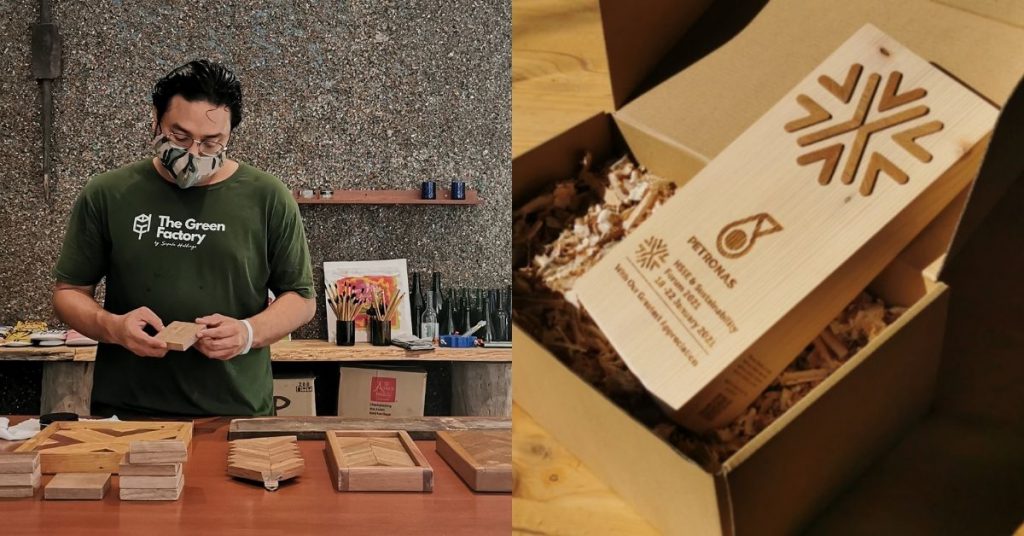When I think about sustainable carpentry, the first thing that comes to mind is reducing woodwork waste, which I assumed is something that just comes with time and experience.
It wasn’t until I chanced upon Harith Ridzuan of The Green Factory who shared more about sustainable carpentry and how he practices it in his factory, that I was enlightened.
“Sustainable carpentry looks into various aspects of production flow and how to make that process greener. Besides our material, we look into the glue, coating, design, documentation, education, community among other factors. We also apply zero-waste manufacturing in our facility while promoting sustainability to the public,” he shared with Vulcan Post.
He Inherited A Woodworker’s Hands
Now, Harith’s family has been in the carpentry business since 1993. Harith began helping his parents during school holidays when he was 10 and was exposed to factory production activities ever since.
“As the first of 10 siblings, I was groomed from a young age to take over the family business,” he shared.
“After I finished my studies in 2008, graduating in Management from the University of Nottingham UK, I officially joined the family business and took professional carpentry lessons.”
Within the first few years of taking over the business, he experimented with a lot of recycled materials and greener processes in timber manufacturing, which Harith said not many carpenters were looking into at the time.
A bulk of the revenue for The Green Factory actually comes from the legacy business that Harith’s family always had, which are interior fit-outs and government contracts.
Dictionary Time: An interior fit-out is the process of making an interior space ready for occupation and refurbishing, which comes with putting up structural features like window placements, door fittings, heating, plumbing, and ventilation.
Stovall Construction Inc.
The Green Factory usually takes in 20-35 workers at a time, as they train about 20-24 students per year.

However, as Harith delved more into sustainable carpentry, The Green Factory started a new venture selling green furniture for the public.
This new venture is mainly gaining traction from the F&B sector, corporate, and environmental-loving community as well as woodwork enthusiasts.
Some of their notable clients include Mandarin Oriental Kuala Lumpur, Isetan, The Star Media Group, Ben’s, and lululemon. However, they’ve been getting more demand from retail customers in recent years.
What Do They Mean By “Green”?
“From my observation, a lot of our local carpenters are moving towards the right direction especially the ones who upcycle old wood, but there’s more to sustainable manufacturing than just the material,” Harith shared.
Harith explained that carpenters should also consider the entire manufacturing chain such as the designing process, how much waste would come from these designs, using non-toxic coating, how much carbon emissions your workers produce from travelling or using machines, and eco-friendly packagings.
“If you only focus on one aspect, it’s a slippery slope to greenwashing,” he affirmed.
One way they’re walking the talk is by creating wooden phone holders from their offcuts (a waste piece of wood after cutting a large piece). Utilising offcuts also opened up another income stream for them, as they sold thousands of these woodworks as corporate or novelty gifts.

As for wood shavings, they’d collect them and sell them in bags to interested buyers who use them for plant nurseries, composting, and animal bedding. They’d also use them as a replacement for bubble wraps when packing smaller items for delivery.

Not Just A Self-Proclaimed Green Brand
While Harith and The Green Factory hammer a lot (no pun intended) on the “green-ness” of their brand, it’s not without validation.
They’ve won several awards that speak for the eco-friendliness of their brand, like the 2019 Malaysia Timber Certification Council (MTCC) Sustainability Award.
On top of that, the other brands under him, Dapo, Nokta, and oran & bula are all PEFC-certified, which is an international nonprofit certification that is given if a company demonstrates legal and sustainable sourcing of forest products to their customers.
Harith sources some of his wood from PEFC-certified forests, and to maintain that certification, they are audited every year to ensure that they’re complying with the international standards set by the NGO.
Besides all these certifications, Harith also runs the Green Hammer programme, a public outreach programme to raise awareness on adopting sustainability in various industries, educational institutes, and communities.
One of these projects was training Datai Langkawi’s in-house carpenters on how to upcycle old discarded wood from their buildings.
To encourage more discussion about green practices and the adoption of sustainability in businesses, Harith also founded a Facebook group called Green Design Malaysia.
- You can learn more about Harith Green Carpenter here.
- You can read about other startups we’ve written here.
Featured Image Credit: Harith Ridzuan, founder of Harith Green Carpenter


















